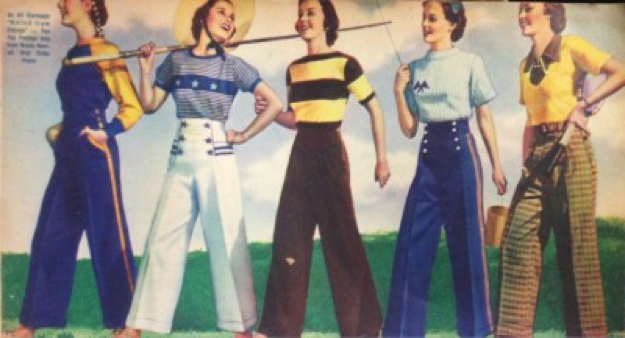
Fashion Rationed: World War II Style
Fashion Rationed: World War II Style
By Paige McKirahan
Though The Great Depression was nearing its conclusion at the end of the 1930s, the fashion industry was still shaking from the effects of its economic downfall. Moving away from the tubular styles of the 1920s, this pre-war period saw the revival of a feminine, waist cinching silhouette and made way for mass, factory produced styles. Don’t worry—corsets were still out of trend and the type of form fitting style that the ‘30s loved was that of an accentuated natural waist. The innovations in industry that made ready-to-wear a staple in design also allowed none other than Elsa Schiaparelli to pioneer zippers, making them a staple in this decade’s garments as they were ultimately less expensive than buttons.
Though daywear styles were simple and refined, evening wear remained glamourous and continued garnering inspiration from Hollywood starlets. Backless gowns became the centerpieces of long gowns and chiffon, silk, crepe-de-chines, and satin were used to create elegant and flowing lines. Women’s pants also became a huge hit in the late 1930s, popularized by “sailor” style which included buttons on the front of the high waist. Beach pajamas, one piece jumpers with wide legged pants, also became a wardrobe staple for women at the time as they were commonly worn for beach or relaxation days.

1938 women’s pants
(image credit to vintagedancer.com)
The beginning of World War II in 1939 placed an emphasis on global conflict rather than haute couture, pushing creative expression to the backburner. To support the war effort, common clothing materials began to be rationed, taking a toll on style and calling for alternative fabrics. Rather than using nylon and wool, which were both needed by the military, a new synthetic fabric called rayon was extremely popular for clothing in these wartime years. These fabric restrictions put a renewed emphasis on legs that we previously saw during World War I; less fabric meant simple designs with shorter hemlines were in now style out of necessity. Fabric rations were also responsible for the creation of the two-piece swimsuit in 1946 as creating a bikini was more economical than one pieces.
An unforeseen shift was brought along in the 1940s that altered the fashion world forever; Paris was knocked from their throne as the leader in haute couture and style, with New York emerging as the new influencer. Parisian couture houses garnered disapproval from the public and many grew weary of top designers as it seemed they were in cahoots with occupational forces. Coco Chanel specifically closed down her studio during this period as she was criticized for her relationship with a high ranking Nazi official, tarnishing her brand. Claire McCardell, American designer, made use of fabrics that were not in high demand by the military like cotton denim, jersey, gingham, and calico for everyday styles. “War Wise” became trendy and patriotic colors were the “it” aesthetics of the decade as American style was making its first true marks on the industry.

Claire McCardell design, 1946
(photo credit to enews.com)
As the Great Depression lead into the new war, costume jewelry was still a wardrobe staple as movie star glam style reigned. Clothing was relatively plain and lackluster, so jewelry was large, colorful and decorative to compensate. Metal was in short supply, so sterling silver became the go to material and provided a base for large, colored gemstones. Vermeil also became popular for these over-the-top pieces; the material, which is a base of silver plated with gold, gave the look of luxury while remaining inexpensive. Cheaper materials such as wood, shell, glass, bakelite, and fabric were used to created pieces with patriotic symbols, flowers, bows, and whimsical animals. Popular motifs during this time included novelty shapes and prints, nature, flowers, fruits, and vegetables. Patriotic themes were common as it was important to keep morale up during the War; many wore brooches that were in the shape of the letter “V”, which was a common symbol for victory in this decade.

Cartier "V" brooch ad, 1945
(image credit to vintagedancer.com)
Despite the glitz of the roaring ‘20s, the late ‘30s and ‘40s were forced to forgo glamourous habits for those more modest on account of the current political and economic climates. Regardless, this time period shows that fashion and style can persevere, molding with the restrictions of the time. Limits on materials forced designers to become innovators, creating timeless silhouettes that were not previously utilized in the industry. American courtiers really began to step into the global spotlight, and New York as a city secured its place as an emerging fashion leader. To celebrate this victory, head over to our collection to get you some ‘30s and ’40s pieces of your own!
